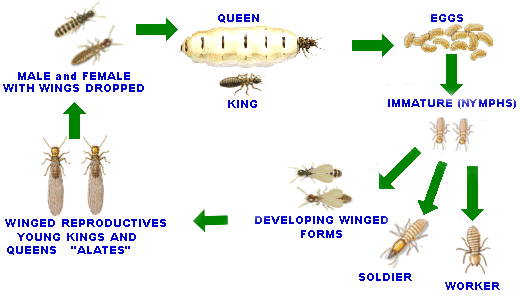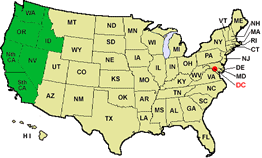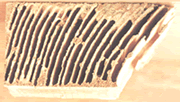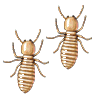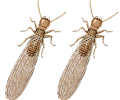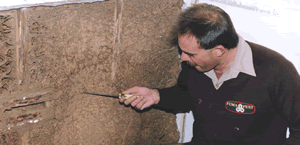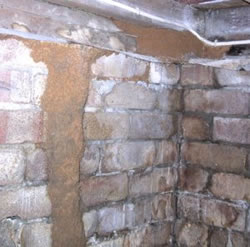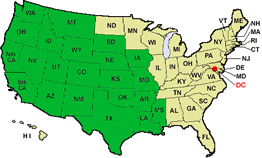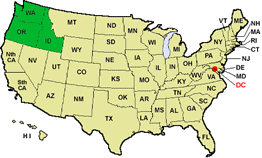|
|
| Destructive Termites in Idaho |

| Identification of the main destructive species |
It is critical to identify the species of destructive termites to formulate
an appropriate control program. The main species of destructive
termites in Idaho are:
CONTENTS: learn about destructive species of termites - tips on identification
of the timber damage - find out when they swarm in your
local area and how to identify the swarmers, workers and soldiers - learn
about their fascinating biology, life-cycle and behavioural aspects - and receive
professional tips on how best to protect your home from the world's best timber
recycler .... subterranean termites. |
| Western
subterranean termites |
| Identification of Timber Damage |
Western subterranean termites are highly destructive to douglas fir and
other common timbers used in the construction of a building. They can rapidly
eat out the internal sections of structural timbers - devouring mainly the
spring wood, and preferring to leave the harder summer wood sections.
As`a result, infested timbers are often left as a thin shell with a honey-comb
of layered hollow sections (as illustrated) packed with moist soil. |
| Western subterranean termites ... destructive nature
|
| The Western subterranean termite is a serious economic timber pest causing
millions of dollars of damage throughout the areas where it is located.
It is estimated that more than 1 in 5 homes in the high activity areas have
been or will be attacked at sometime by these voracious little insects. |
| The life-cycle of subterranean
termites |
| Biology of western subterranean termites |
Within a termite nest there are members of different castes, each with a
different role to perform and all interdependent upon each other for survival
of the colony. These include the queen, king, the winged reproductive (young
kings and queens), soldier and worker termites.
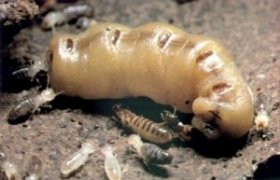
The king, queen and worker termites. |
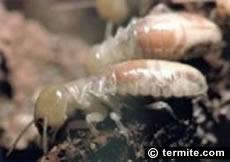
Worker termites - thin external skin. |

|
The queen termite is an egg laying machine; her body is enormous
compared to her off-spring; she can live more than 25 years and produce
more that 2,000 eggs a day. |
|
|
The king and queen live in a central chamber and are tended by
the workers. |
The workers are by far the largest
caste in the western subterranean termite colony and
the one that does the damage; they are a creamy translucent colour,
soft bodied and carry out all work in the nest, including gathering
food (timber and other cellulose); constructing tunnels; repairing
and enlarging the colony nest; grooming each other and feeding the
soldiers, the king, queen and also caring for the young nymphs until
mature.
IDENTIFICATION: Western subterranean worker termites are small in size, about half the size of
match-head or 1/8" long and are soft bodied insects. They have no wings, are sterile,
blind and work 24 hours a day for their entire 2 year life span.
|
The soldiers are the defenders of the
colony, particularly against marauding ants - with whom they have
engaged in a relentless war lasting 250 million years.
IDENTIFICATION: the soldiers have an
orange coloured rectangular armoured head with mandibulate pinchers which they use to crush the ants. On their forehead is a fontanelle
(frontal gland pore) used to emit a sticky latex to ensnare the ants.
The soldier termite is usually the first to be seen in large numbers
when any active termite workings (mud shelter tubes or damaged timber)
are opened. Soldier termites will rush out to guard the opening whilst
worker termites repair the breach. |
The swarmers (reproductives) are
called "alates"
and are commonly seen when they swarm during daylight; they have eyes; are poor fliers but are swept along by
the wind; they land, drop their wings, find a mate to become king
and queen of a new termite colony.
IDENTIFICATION: The western subteranean termite swarmers are about 3/8" long (including wings) with a dark brown
body and a small fontanelle (frontal gland pore) on its head. Their wings are brownish grey with two dark solid veins along the forefront
of the front wings. The front wing is distinctly larger than hind wing.
WHEN DO THEY SWARM? In the southern part of their range, swarming
takes place in the spring, but without rain. In the southern areas, swarming usually follows rain. The swarmers are emitted in their
thousands when a mature termite nest is large and well established.
Western subterranean termites swarm in large numbers over a wide area
to find a mate from another colony nest to start up a new colony.
A suitable location for nesting should provide moisture and a readily
available timber food source close by.
Colony nest development is slow in the first few months, with the
egg-laying capacity of the new queen termite peaking after a few years.The
swarmers are emitted in their thousands when a mature termite nest
is large and well established. Swarmers are usually produced after
this period and are an indication a large termite nest is in the vicinity,
a sure danger sign and a warning that professional protection is required.
The colony nests of Western subterranean termites are usually located
in the ground below the frost line, but above the water table. Mud
galleries or "shelter tubes" are constructed across hard
objects in order to gain access to timber food sources.
Western subterranean termites constantly search for new food sources.
They are known to enter buildings through cracks in concrete flooring
or to travel under parquetry or tile flooring through gaps of less
than 1/16" wide.
Where moisture regularly collects inside the wall or other cavities
of a building, say from faulty plumbing or broken roof tiles, the
Western subterranean termite can develop a subsidiary colony nest
which may not require contact with the ground to ensure it's survival. |
They build a central colony nest from
which they construct underground tunnels that radiate within a 100 yard
radius from a central colony nest in search of a timber (cellulose) food
source.
The picture on the left shows a termite inspector examining
an above ground termite subsidiary nest built inside a wall
cavity of a home.
Termites often build such nests if moisture is allowed to regularly
collects inside the wall cavity, say from leaking pipes, shower
recess, faulty plumbing, guttering, broken roof tiles, etc.
|
Termites travel in humidified mud-shelter tubes or galleries...
The picture on the left shows a mud shelter tube that subterranean
termites have constructed over a solid object, in this case,
a brick foundation wall in the sub-floor of a cottage.
Subterranean termites travel in these mud shelter tubes as protection
from predators, sun-burn, dehydration and to maintain a high
humidity environment which is essential for their survival.
Western subterranean termites are highly secretive, preferring
to enter a building through areas inaccessible to inspection,
such as, through in-fill patios, fire heaths, expansion joints
and cracks in concrete slab (on-ground) flooring.
Western subterranean termites can pass through a 1/8" crack
or an expansion joint (eating through the rubber compound) between
adjoining concrete on ground flooring. They can also travel
under parquetry and floor tiles to get to the wall framing timbers.
|
|
Only the worker termite caste can digest timber by the use of symbiotic
protozoa in their gut. Worker termites feed their partly digested semi-liquid
food, regurgitated from their mouth or passing from their anus, to the other
termites, a process known as trophallaxis.
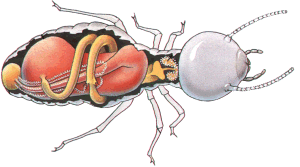
|
Western subterranean termites have a well ordered social system with
amazing engineering capabilities and an acute survival instinct; they
obtain moisture from the soil and moist decaying timber, and communicate
using pheromone signals.
The mutual feeding, constant grooming and close social habits
of termites are used to advantage in modern termite control
baiting systems. |
Certain hi-tech termite baits are now on the market that have a delayed
lethal effect on termites which readily pass on the bait to other termites
in the central colony nest during the mutual grooming and feeding.
 |
Western subterranean termites need to maintain a high level of humidity
and temperature (75 to 95F) in their central colony nest.
Western subterranean termites eat through the centre of susceptible
timbers leaving nothing but a thin veneer of timber and/or paint.
They will pack mud in cracks and joints in timber to prevent loss
of humidity and resultant dehydration. |
|
As noted above, termites constantly groom and feed each other. A valuable
technique for the termite controller is to instal and monitor a termite
baiting system next to any live activity found in and around the premises
where termite foraging is most likely to occur. Subsequent inspections (preferably
monthly) may reveal dead or sick worker termites, they change colour to
a mottle look, and spread of the termite bait to other termites leading
to elimination of the colony.
The termite baits are designed to be non-repellant to the termites and has
a unique delayed effect. Time enough to be passed onto the other termites
in the colony including the queen, with a sufficient dosage leading to the
elimination of the entire colony. This process is explained in detail in
the Termite Control section of this website. |
| If You find these termites do NOT disturb them |
Western subterranean termites have acute survival instincts. If they
are shaken up or disturbed, the termites often will abandon the associated
area and move on to secretly cause damage in other areas in the building.
If you find western subterranean termites in or around your property, it
is essential that you do NOT disturb them and promptly arrange for a professional
inspection and application of a termite bait to the live termites, if present
in abundance.
 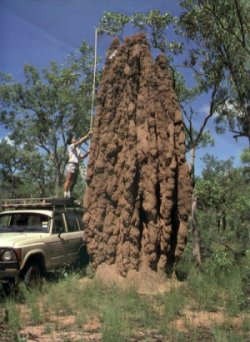 |
Subterranean Termites...
Mother Nature's most prolific builders
This picture shows a large above ground termite nest found in the
Northern Territory of Australia. In the USA, most of the destructive
subterranean termite species build their nest completely below ground
level.
A large colony in an urban environment is most often unseen, being
totally below ground level with a nest containing more than a million
termites - the damage can be devastating.
Find Out How to Protect Your Property
Click
on Subterranean Termite Control
|
|
| Arid-land
subterranean termites |
Area of Distribution: The Arid-Land subterranean termite is commonly found
from the Pacific Coast to Indiana, and southwards from Montana to lower
California, Texas, and Mississippi. It is by far the most common and destructive
termite in Arizona.
Identification of Swarmers and Soldiers: In locations below 4,000 feet the
Arid-land termite swarms between January and March. Above 4,000 feet, they
usually swarm in June and July. The swarmers are about 1/3” long with
wings, and 1/5” long without wings. Their wings are almost whitish,
with brown veins in the fore area. Swarmers are dark brown to black in color.
The soldiers are 1/4” long, with jaws that are nearly straight. They
resemble the jaws of the desert termite but are slightly thicker.
Biology and Habits: The Arid-land subterranean termite has been found living
in sand dunes, as well as at altitudes above 7,000 feet in the Rocky Mountain
states. It is also found in moist river low lands and along streams and
canyons, but essentially it is a desert or prairie species. Arid-land subterranean
termites naturally occur in deserts where they attack creosote and greasewood
bushes as well as buildings and other timber structures.
|
Area of distribution: This species is found from central California to British
Columbia and eastward into Idaho, Nevada and Montana. Primarily a forest
dwelling termite this termite is the common termite found in the Californian
mountains. Higher and drier altitudes are preferred, ranging up to 9,000
feet above sea level.
Identification of Swarmers and Soldiers: Soldiers are similar in appearance
to the Pacific dampwood termite, but with longer heads with straighter sides.
The swarmer is a darker brown than the Pacific dampwood termite.
Identification of Timber Damage: The appearance of the damage inflicted
upon timbers by this species is very similar to the Pacific dampwood termite.
Biology and Habits: This species is very similar in habit to the Pacific
Dampwood termite. This species will attack wood of all types throughout
its range. Timbers in contact with the soil or structures built near or
over water are common targets. This species is known to be very tolerant
of moist conditions, even being found in pilings subject to tidal flooding.
Colony size varies but may contain as many as 4,000 individuals.
Colony growth is aided by the production of secondary reproductives. Like
other termites this species aid in the spreading of wood decay fungi, the
spores of which are carried in the gut and on their bodies. A well established
colony will produce winged reproductives which may infest nearby timber.
|
| Published by Fumapest Group © copyright 1995
-
|
|
